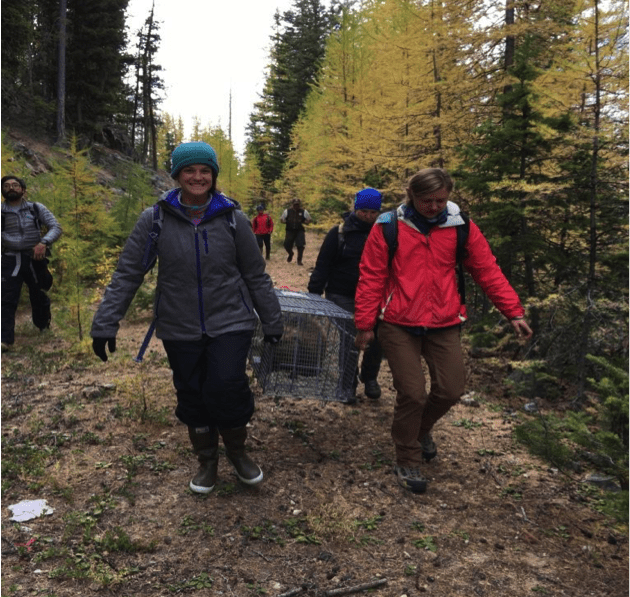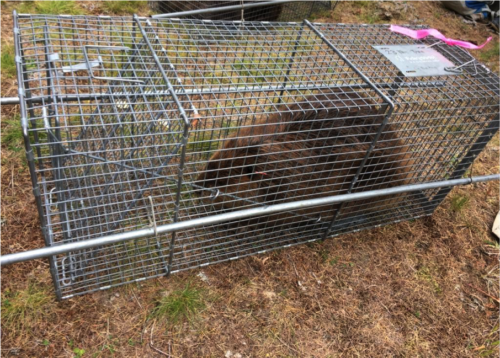
Who Cares About Beavers? We Do!
By Melissa Biggs, graduate student in the Institute’s 16th cohort.
Everyone, meet Chompers! In October 2016, during the fall natural history trip, my cohort helped the Methow Beaver Project volunteers to release the last 3 beavers of the season. So much fun! We carried the beavers for several miles and released them at Beaver Creek. When we opened the cage, Chompers went right into the water. It was fascinating to watch the three beavers explore their new environment. This summer, the Methow Beaver Project workers will locate Chompers and the other two beavers to record their journey since the fall. This experience made me more curious about beavers and their role in the ecosystem. As I did more research, I realized how awesome beavers are!
Beavers are so wonderful that they are known as environmental engineers. Beavers are known as a “keystone” species because of their large effects on landscapes. It only takes a few beavers to transform a watershed entirely. Beavers, with the exception of human beings, do more to shape their landscape than any other! Beavers are also a “foundation” species because their presence and their creations, such as dams, allow other plants and animals to exist.
Beavers’ creations are essential to its environment for many reasons. First, beaver dams are natural filters, as they capture and store much of the sediment. Streams that have been shaped by beavers have 10 times greater purification capability than streams without beavers. Also, beaver dams store water, thus leading to the increased size of wetlands. Beaver dams can help mitigate the effects of drought and the loss of wetland and riparian habitats due to their abilities to store shallow groundwater and retention of surface water behind dams. This is important because almost half of endangered and threatened species in North America rely upon wetlands. Also, freshwater wetlands have been rated as the world’s most valuable land-based ecosystem. Beaver ponds increase both the water we can see on the surface and also what is stored beneath the pond. This helps increase the riparian area and vegetative productivity. Not only do beaver dams store water, they also help slow down the water flow, which is why they are known as ‘nature’s speed bumps.’ They reduce stream velocity and power, which helps reduce erosion rates and the amount of sediment carried downstream. This effect across the upper watershed could provide more time for flood planning, protection and evacuation of high risk, residential areas. Beaver ponds also help stabilize the water temperature both in the shallow and deeper areas – they help cool down streams, creating better conditions for fish, especially trout. Last, but not last, beavers’ modification on watersheds help increase organic material, such as cut wood and flooded plants, sediment with nutrients attached and more water surface area for photosynthesis to occur, which results in more aquatic biodiversity and food for fish. Without beavers and the role they play in watersheds, most of the biodiversity that are associated with wetland habitats would disappear.

Chompers in his cage right before he’s released! Image courtesy of Melissa Biggs
As I mentioned earlier, Cohort 16 helped the Methow Beaver Project to release three beavers. Why are they doing this project? The Methow Beaver Project Accomplishments 2015 Report was released and the results are amazing. The Methow watershed has benefited from beavers. According to the project data: “beavers we released have added 780 acres of wetland habitat, 19 acres of pond surface, 780 acres of riparian habitat, and improved 19 miles of stream habitat. 4875 acres of adjacent upland habitat is improved because of beaver dams built.”
The Methow Beaver Project also talks about the cost benefits of beaver management. In the last 8 years, they have been able to reduce: problems associated with irrigation infrastructure, the loss of shade, maintenance on road impacts, and the loss of orchard trees. Also, it is estimated that the financial benefit to landowners is at least $1,000 per beaver moved, as well as, the “key economic benefits of beaver project salaries, project expenditures, ecosystem benefits, and costs avoided are estimated to have contributed at least $605,000 to Okanogan County residents in 2015 and nearly $4 million since we began the expanded project in 2008.” Without education, the Methow Beaver Project would have not been as successful. The volunteers spent a lot of effort reaching out to the landowners of the Methow Valley. Fortunately, their efforts were paid off. Forty-four landowners reached out to discuss possible solutions to beaver issues and the variety of benefits beavers provide. The project staff members were able to assist 38 of those landowners with technical advice and/or relocation services. The beneficial effects of beaver habitat have been undervalued partly due to the public’s lack of knowledge about beavers. Education is an effective tool to use to help get others on board on helping restore beaver populations.
Besides humans, these creatures are the only species that can impact the landscape significantly and that’s why they are known as ‘environmental engineers!’ Beavers have been living on Earth for millions of years. We as humans need to learn to work and live together with beavers so they can continue to work their magic on landscapes to help improve the negative environmental impacts that are happening.

